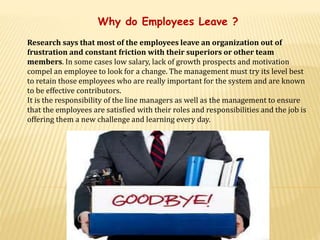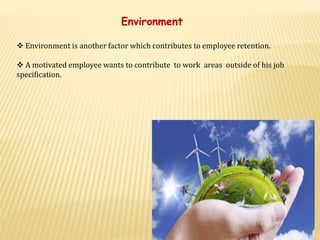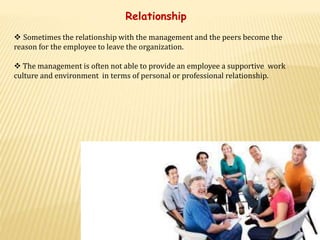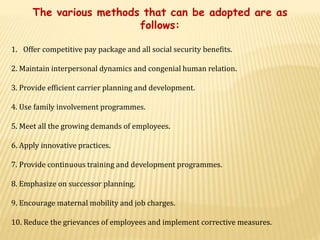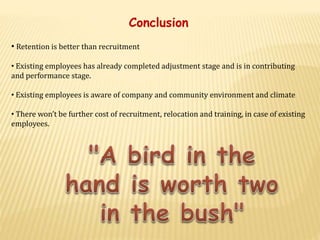Employee_Retention_Neha
- 3. What is Employee Retention ? Employee retention refers to the various policies and practices which let the employees stick to an organization for a longer period of time. Every organization invests time and money to groom a new joinee, make him a corporate ready material and bring him at par with the existing employees. The organization is completely at loss when the employees leave their job once they are fully trained. Employee retention takes into account the various measures taken so that an individual stays in an organization for the maximum period of time.
- 4. Why do Employees Leave ? Research says that most of the employees leave an organization out of frustration and constant friction with their superiors or other team members. In some cases low salary, lack of growth prospects and motivation compel an employee to look for a change. The management must try its level best to retain those employees who are really important for the system and are known to be effective contributors. It is the responsibility of the line managers as well as the management to ensure that the employees are satisfied with their roles and responsibilities and the job is offering them a new challenge and learning every day.
- 5. Retention involves 5 major things Compensation Environment Growth Relationship Support
- 6. Compensation Compensation includes largest part of retention process. The employees always have high expectations regarding their compensation package. Compensation includes : 1) salary and wages 2) Bonus 3) Health Insurance 4) After retirement benefits 5) Incentives 6) Appraisals
- 7. Environment Environment is another factor which contributes to employee retention. A motivated employee wants to contribute to work areas outside of his job specification.
- 8. Growth • Growth is the integral part of every individuals career. • If an employee cannot foresee his path of career development in his current organization, there are chances that he may leave the organization as soon as he get a new opportunity.
- 9. Relationship Sometimes the relationship with the management and the peers become the reason for the employee to leave the organization. The management is often not able to provide an employee a supportive work culture and environment in terms of personal or professional relationship.
- 10. Support Employees today are asking for workplace that help them balance the demands of their work and family lives, rather than forcing them to choose one over the other. Schemes like: 1) Special schemes for their children 2) Scholarships 3) Medical Benefits. 4) Travel and holiday etc. Supportive work culture helps grow the employee professionally and boost employee satisfaction. There are times when employee starts feeling bitterness towards the management or peers which leads to less satisfaction and eventually attrition
- 11. Low Level • Appreciating and recognizing a well done job. •Providing Benefits •Providing Perks •Providing workplace convenience. •Fun at Work •Occasional stress relievers •Employee support in tough time and personal crises. •Recognizing professional as well as personal significant events. Mid Level •Appreciating and recognizing a well done job. •Benefit programs for family support. •Providing convenience at workplace. •Providing training and development with personal growth opportunities High Level •Promoting work/life effectiveness. •Understand employee needs •Encouraging professional training and development and personal growth opportunities. •Providing an environment of trust. •Hire the right people from the beginning 3 Levels
- 12. Let us understand the concept of employee retention with the help of an example: Misha was a talented employee who delivered her best and completed all her work within the desired time frame. Her work lacked errors and was always found to be innovative and thought provoking. She never interfered in anybody else’s work and stayed away from unnecessary gossips and rumours. She avoided loitering around at the workplace, was serious about her work and no doubts her performance was always appreciable. Greg, her immediate boss never really liked Misha and considered her as his biggest threat at the workplace. He left no stone unturned to insult and demotivated Misha. Soon, Misha got fed up with Greg and decided to move on.
- 13. Situation 1 - The HR did not make any efforts to retain Misha and accepted her resignation. Situation 2 - The HR immediately intervened and discussed the several issues which prompted Misha to think for a change. They tried their level best to convince Misha and even appointed a new boss to make the things better for her. In Case of Situation 1 would most likely leave the organization in the lurch. It is not easy to find an employee who gels well with the system and understands the work. Hiring an employee, training him and making him fit to work in an organization incur huge costs and thus sincere efforts must be made to retain the employee. Every problem has a solution and the management must probe into the exact reasons of an employee’s displeasure. Employees sticking to an organization for a longer time tend to know the organization better and develop a feeling of attachment towards it. The employees who stay for a longer duration are familiar with the company policies, guidelines as well as rules and regulations and thus can contribute more effectively than individuals who come and go. Employee retention techniques go a long way in motivating the employees for them to enjoy their work and avoid changing jobs frequently.
- 14. Try these tactics to retain your employees. Offer a competitive benefits package that fits your employees’ needs. Providing health insurance, life insurance and a retirement-savings plan is essential in retaining employees. But other perks, such as flextime and the option of telecommuting, go a long way to show employees you are willing to accommodate their outside lives. Provide some small perks. Free bagels on Fridays and dry-cleaning pickup and delivery may seem insignificant to you, but if they help employees better manage their lives, they’ll appreciate it and may be more likely to stick around. Conduct “stay” interviews. In addition to performing exit interviews to learn why employees are leaving, consider asking longer-tenured employees why they stay. Ask questions such as: Why did you come to work here? Why have you stayed? What would make you leave? And what are your nonnegotiable issues? What about your managers? What would you change or improve? Then use that information to strengthen your employee-retention strategies. Use contests and incentives to help keep workers motivated and feeling rewarded. Done right, these kinds of programs can keep employees focused and excited about their jobs.
- 15. Communicate your business’s mission. Feeling connected to the organization’s goals is one way to keep employees mentally and emotionally tied to your company. Foster employee development. This could be training to learn a new job skill or tuition reimbursement to help further your employee’s education. Create open communication between employees and management. Hold regular meetings in which employees can offer ideas and ask questions. Have an open-door policy that encourages employees to speak frankly with their managers without fear of repercussion. Get managers involved. Require your managers to spend time coaching employees, helping good performers move to new positions and minimizing poor performance. Offer financial rewards. Consider offering stock options or other financial awards for employees who meet performance goals and stay for a predetermined time period, say, three or five years. Also, provide meaningful annual raises. Nothing dashes employee enthusiasm more than a paltry raise. If you can afford it, give more to your top performers. Or, if you don’t want to be stuck with large permanent increases, create a bonus structure where employees can earn an annual bonus if they meet pre-specified performance goals.
- 17. An organization enjoys following benefits due to employee retention: 1. Existing employee’s skills, talent, and values are known to the organization. 2. Existing employee’s cultural fit, performance, attitude, etc. are already judged. 3. Existing employee’s aspirations and expectations are clear 4. Employees’ adjustment with the company’s climate and environment. 5. Cost of recruitment and training will not be incurring. 6. Even the employee’s family members get adjusted with the company’s environment. 7. Family welfare programmes.
- 18. The various methods that can be adopted are as follows: 1. Offer competitive pay package and all social security benefits. 2. Maintain interpersonal dynamics and congenial human relation. 3. Provide efficient carrier planning and development. 4. Use family involvement programmes. 5. Meet all the growing demands of employees. 6. Apply innovative practices. 7. Provide continuous training and development programmes. 8. Emphasize on successor planning. 9. Encourage maternal mobility and job charges. 10. Reduce the grievances of employees and implement corrective measures.
- 19. And the result of good retention process is like this
- 20. Manager’s role in employee retention strategy Creating motivating environment Standing up for the Team Providing coaching Delegation Extra Responsibility Focus on future career Career Planning
- 21. How to reduce employee turnover Extract DIAMONDS among the stones Giving a finishing touch to your Diamond Compensation package for those who make your organization worth
- 22. Attrition is it really BAD???? If all the employees stay in the same organization for along time most of them will be at the top of their pay scale which will result in excessive manpower cost. When certain employees leave whose continuation of service would have negatively impacted productivity and profitability of the company, the company is benefited. There are some people in the organization who have negative and demoralizing influence on the work culture and team spirit . This in the long term is detrimental to organizations health. New employees bring in new ideas, approaches abilities and attitude which can keep the organization from becoming a stagnant.
- 23. Contd….. Desirable attrition also includes termination of employees with whom the organization does not want to continue a relationship. It benefits the organization in the following ways. 1) It removes bottleneck in the progress of the company. 2) It creates space for the entry of new talent s 3) It assists in evolving high performance teams.
- 24. Conclusion • Retention is better than recruitment • Existing employees has already completed adjustment stage and is in contributing and performance stage. • Existing employees is aware of company and community environment and climate • There won’t be further cost of recruitment, relocation and training, in case of existing employees.
- 25. Live example of the best company in Employee Retention. Anshul Life science: Anshul life science is a very old client of Erudite Management solutions and a good company to work with. The employees which are place in Anshul Life Science are very happy and don’t leave the organization until its very necessary. Anshul believes in their employees and provide them career path to grow.
- 26. Known devil is better than unknown angel




